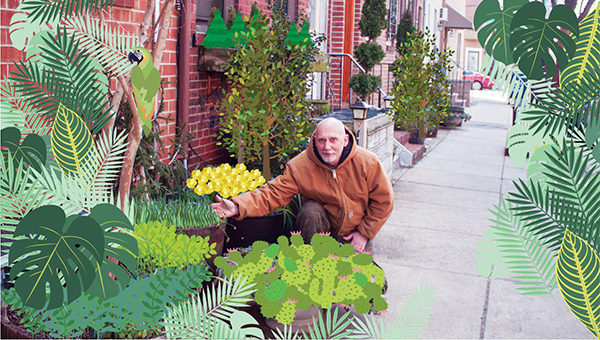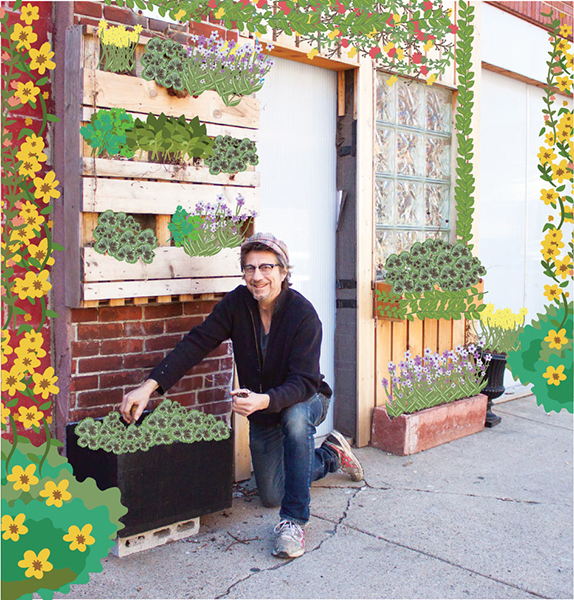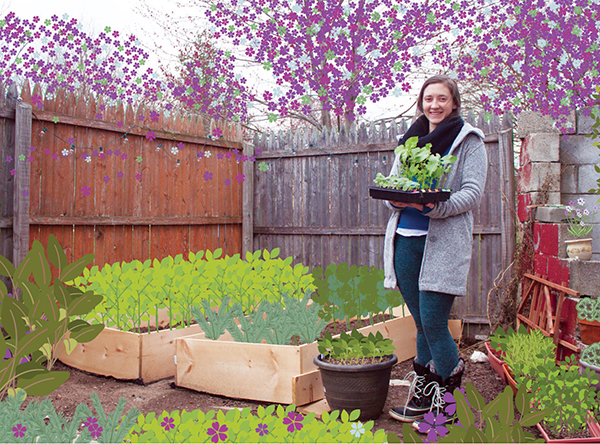Photos and illustrations by Marika Mirren
How Does Your Garden Grow?
by Brion Shreffler
Turning the corner of South 10th and Christian streets in Philadelphia, heading north into the Bella Vista neighborhood, a newcomer out on a jog might be caught off guard by the fiercely squawking green parrot taking umbrage at their swift passage.
Stopping to note the parrot ensconced in his tree, said jogger might register the equally out-of-place headdress of elephant ears in a planter adjacent to the tree. As their eyes quickly shift right toward the façade of South Philly row homes, they’d find three massive aquatic pots holding blooming water lilies before jumping over potted miniature evergreens, a koi fish and turtle pond with a blooming water hyacinth, a window box full of assorted flowers, and more potted plants and evergreens—next to even more tropical plants.
These plants and trees decorate the exterior of the home of Robert Nuse—that’s his parrot—as well as the homes of his immediate next door neighbors, for whom he also does sidewalk gardening. He’s a contractor and property manager who studied agriculture, and he goes all out with planters and pots, just like many other row home dwellers.
As of early March, he’s getting ready for spring, just like many other Philadelphia gardeners who make the most of their green thumbs while having little to no green space.
Mathew Davis, a landscape and general architect who lives a bit further south, saw the potential in a former garage that he renovated for his new home. While he has a few sidewalk planters and a window box made from a wooden pallet, the 1,500-square-foot space atop the roof he repaired is where he tends to a roughly 50/50 blend of edible plants (vegetables and herbs) and ornamentals.
And on the other side of the city, Jenna Brown, who studied environmental science, is making the most out of a small North Philly backyard that doesn’t have soil conducive to planting—it’s situated within a commercial/industrial zone. She’s utilizing raised beds and a variety of planters and pots accumulated by the building she lives in.
A purpose for every pot
“It’s just pure hobby,” Nuse says, referring to the abundance of green that adorns the sidewalk here, including the tropicals he puts out once summer hits. You’ll want to see the two banana trees, but perhaps skip the Japanese devil’s tongue during the week and a half that it’s in bloom—its flower brings the charming aroma of decaying human flesh.
“I enjoy the shock value of it, to be honest with you,” he says. “People aren’t expecting to come across this in the city.”
He’s had the window planter that overlooks his do-it-yourself koi and turtle pond for 30 years. Prior to moving to his current address 23 years ago, that planter was bolted to the railing of a fire escape that held pots of various flowers on each step leading up to his apartment.
He started slowly once he moved to South 10th Street. By his fifth or sixth year, he was managing planters for neighbors on both sides of his property. Six-foot-tall topiaries frame his door and that of his neighbor to the left, who also has the three aquatic lily pots in front of their façade.
Brown takes a different tact, and only grows vegetables and herbs.
“You know exactly where your food is coming from, and knowing all of the energy you put into it makes you appreciate it more,” Brown says. “You have a strong bond and relationship to it.”
No ornamentals?
“I can’t keep a houseplant alive,” she admits.
Having just moved in, she’s looking forward to having a garden once again. Her most recent experience was running a garden plot tied to a yoga studio where she’s employed as an instructor.
Davis says his rooftop experiment goes beyond growing food for himself and raising starter ornamentals for clients. He intends to try his hand at building solar panels to power the pumps for the hydroponic systems he’s currently toying with.
While Nuse’s gardening is all about fun and engendering stunning visuals, and Brown’s is about self-reliance, Davis goes even one step further. “It’s about creating autonomous, localized economies as potential major stressors loom,” Davis says, “instead of relying on massive multinational corporations to provide us with energy and food.”
Start of the spring season
As of early March, Davis and Brown have planted seedpods for crops such as cucumbers, beans, peas, chives, broccoli and tomatoes. Once the warm weather sets in, the plants will be hearty and ready to thrive outdoors. Davis has grown salad greens and kale inside his greenhouse over the winter. Brown is planting those same greens as soon as her order from Bennett Compost arrives to mix with the organic soil she put in her newly constructed raised beds. Both also have cold-weather-hardy herbs such as rosemary and thyme planted outside.
While Davis plans to scale back the amount of ornamentals he tends—“too much work”—he’s looking forward to his perennial wildflowers and ornamental grasses popping up once again.
“I try to plant exclusively native species,” he says. “These things are designed to be in this part of the world.”
Nuse, on the other hand, loves trying new exotics. “I always want to do something different,” he says. “I’ve tried pitcher plants and they died both times. I’m not sure what I’m doing right or wrong. I had an Australian tree fern that grew up to about 20 feet before it died on me. I got another one but it’s struggling.”
While Davis has his many consultations to draw upon—he previously served as lead designer at Longwood Gardens—and Brown keeps a gardening journal, Nuse says that decades of mental notes inform his trial-and-error process as he explores growing new plants.
One thing he stresses—particularly to clients as a property manager—is year-round care, and not having dead pots.
So, besides planting winter blooming pansies, he has pots holding daffodil, crocus and tulip bulbs planted in the fall, which should be in bloom by the time you’re reading this article.
Choosing plants to fit the changing environment
Growing on any given location presents its own unique problems—and Nuse’s situation proves that those can change over time.
“Those pin oaks,” he says, referring to the massive trees opposite his property on the west side of the street, “weren’t there when I first moved in.” So while he’s trimmed back the smaller tree on his slice of sidewalk, he’s had to either find sunny spots for certain plants or call upon more shade-tolerant plants—something Davis frequently recommends for clients in South Philly with small swaths of backyards with varying amounts of sunlight.
Ferns, coral bells, hostas—plants Davis grows himself on the shadier parts of his roof—are what he recommends for shade-heavy backyards. He stresses that it comes down to balancing the direction from which your plants receive sunlight along with how much sun they need. For instance, the afternoon sun is perfect for tomatoes, but could be too much for other plants.
To shelter his ferns and other shade-loving plants from the afternoon sun, Davis’ greenhouse is lined along the top with repurposed polycarbonate panels from The Resource Exchange in Kensington.
“I try to use all reclaimed materials. I trash-pick a lot of stuff,” Davis says. Many of his “planters” happen to be 5-gallon “juice” buckets discarded by South Philly amateur winemakers.
He’s found a way to prevent his plants’ extra water needs from adding to his chores by constructing a passive drip-irrigation system that emanates from two rain barrels.
Brown found that the compact ground of her backyard was full of rocks and chunks of cement; her property was also apparently part of a cemetery. So she built her two, 2-by-4 raised beds from cheap lumber. “It took me three hours, including the trip to Home Depot,” she says.
And then there’s the likely toxicity of the soil.
“You shouldn’t put anything in the ground pretty much anywhere north or south of Center City,” Davis advises.
“When I lived in Northern Liberties at 5th and Girard, I had my soil tested and it came out at over five times the permissible levels of lead and cadmium.”
For his part, Nuse states that he has found that certain plants can’t take the wind exposure of being on the sidewalk. For some of his tropical plants, he recently installed large windows in his attic to help keep them warm during winter.
With barren dirt on her property, which should make for fewer weeds, and ample sunlight from the south, east and west, Brown doesn’t expect much difficulty in growing her vegetables. That is, unless a particularly bad pest sets in.
Nuse says he thankfully doesn’t have to guard against as many human pests as when he first moved in.
“I would take wire and wrap it around the plant and tie it to the barrels,” he says. He’d then weigh them down with cinder blocks, a tactic he still uses.
“The fact that the neighbors enjoy this so much—they look out after things,” he says.
While Brown looks forward to community dinners using her produce, Davis echoes sentiment shared by Brown and Nuse while speaking of the aesthetic his garden creates: “In mid-summer, it’s beautiful to have five different types of bees flying around while providing a habitat for other native species. It’s a beautiful place once it gets growing.”






